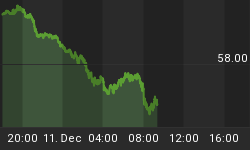TIPS have gone from being rich on an absolute basis, but cheap against nominal bonds, to (still) rich on an absolute basis, but fair versus nominal bonds as nominal yields have risen. That statement is based, however, on a static equilibrium - given where nominal yields are now, after a 40bp selloff since July, real yields have fallen slightly (see chart, source Bloomberg - nominal yields in yellow, real yields in white) and are about right.

I have previously documented this move, pointing out the rise in breakevens and/or inflation swaps. However, because I was traveling I didn't write anything following Friday's skyrocketing breakevens, which followed through on Monday to within a couple of basis points of all-time highs (see chart, source Bloomberg).

That leap seemed exceptionally surprising to some, given the weakness of core CPI on Friday. But inflation expectations on Friday were still reacting to the Fed's open-ended QE move, which had moved 10-year breakevens to near 2.50% on Thursday. After sleeping on it, many investors realized what we realized immediately: there is nothing deflationary about buying bonds without limit, using money printed for the purpose. The Fed professes to be concerned about the negative tail risk to growth (which they can do nothing about), and ignores the positive tail risk to inflation (which they could do something about, if they chose). It is not at all surprising that breakevens leapt.
As I said, these recent gyrations have moved TIPS to being approximately fair value relative to nominal bonds, given the yield of nominal bonds. But the further question is whether those nominal yields are themselves at fair value, or are on the way to higher or lower levels.
A reasonable question to interpose here is this: is this as good as it gets for bonds? What could be better than unlimited Fed buying? Well...I suppose unlimited buying in Treasuries, as opposed to mortgages, would be better, but with 10-year yields at 1.81% one would think that both a considerable amount of buying and a considerable amount of bad economic news is priced in. To be sure, the news continues to be bad; Friday's -10.41 print in the Empire Manufacturing Survey was the lowest since the dip in 2008-09. Lower than the "cash for clunkers" hangover in 2010. Lower than the post-Japanese-tsunami drag in 2011.
But consider this: in the throes of a much worse crisis (especially demographically), and with the Japanese central bank making only timid efforts to resist deflation - and certainly not buying every bond in sight, as the Fed is - the average yield of 10-year Japanese government bonds (JGBs) from 1997-2007 was 1.51% (see chart, source Bloomberg).

Even if you take the crisis-on-a-crisis period of post-2008 for Japan, the average 10-year yield is about 1.15% - and that's with deflation in full bloom and the central bank until the last year or so doing little to fight it.
In Japan, core inflation is at -0.6% over the last 12 months, and 10-year yields are at 0.81%. Our core inflation is 1.3% higher and our nominal yields only 1% higher. There is a lot of disinflation and/or Fed buying that is already in the price. I am not saying that we ought to be selling nominal bonds here; I've gotten burned on that call in the past, and anyway we are in the middle of the strongest bullish seasonal period of the year for bonds. But the Fed just added to the length of the possible "high inflation tail" outcome - and I fail to see what the offsetting bullish tail is. I can't imagine why anyone would buy nominal bonds at these levels, given what the Fed and their pals at other central banks are doing.
But if nominal yields do rise further, this means that TIPS yields will eventually start to rise as well. I still prefer TIPS to nominals, and I still want to be long breakeven inflation, but admittedly it is a more difficult trade at these levels than it was back on August 7th, when I first noted that our Fisher model indicated a short position in TIPS and a long position in breakevens.
I say this, going into a TIPS auction tomorrow with 10-year TIPS yields near all-time lows and 10-year breakevens as I noted near all-time highs. It's not going to feel like a bargain for anyone, but a year from now, it may seem like it.
Now, make no mistake: the core inflation print on Friday of +0.052% was a definite surprise on the weak side. But it wasn't quite as weak as it looked. In fact, thanks to Housing and Transportation, 62% of the CPI major subgroups saw their year-on-year rates of change rise, while only 38% (Food/Beverages, Apparel, Recreation, Education/Communication, and Medical Care) saw those rates decline. Much of the weakness in core inflation came from apparel (which is interesting and worth watching to see if it continues) and large moves in used cars and airline fares. Moreover, as I observed last week, the year-ago comparisons get much easier for the next four months, so that the current 1.9% core inflation print is likely to be the lowest for this year. If it's not, then we'll need to re-assess what is going on, but for now nothing has changed about my forecast. Do note that the Cleveland Fed's Median CPI was unchanged again up at a 2.3% y/y rate of change, reinforcing the fact that the core decline over the last few months has been driven by some outlier price movements rather than by a shift in the central moment of the distribution.
















